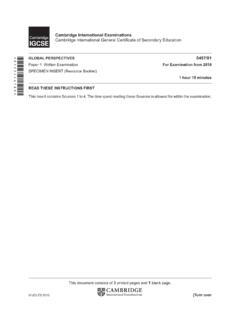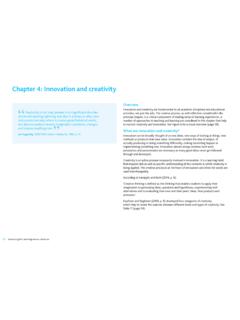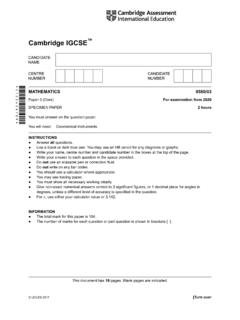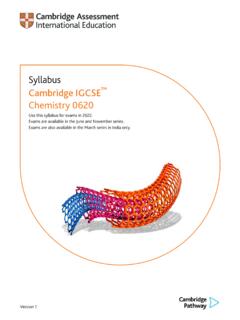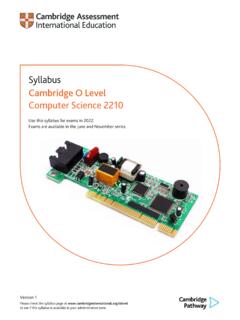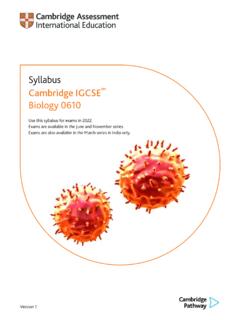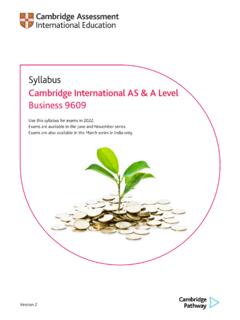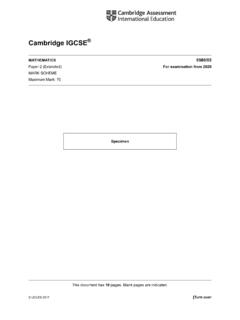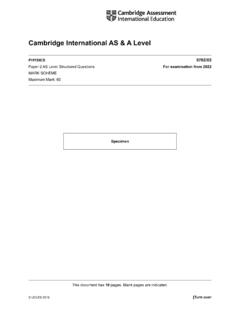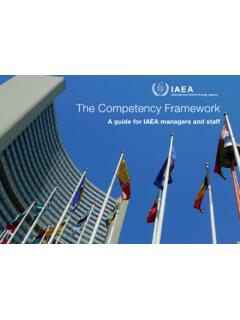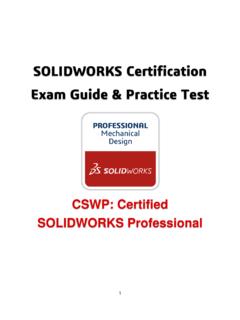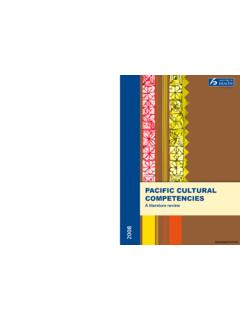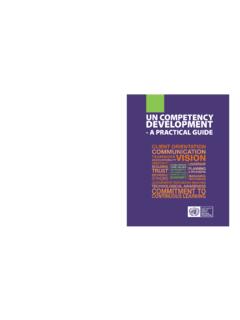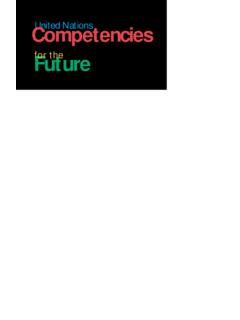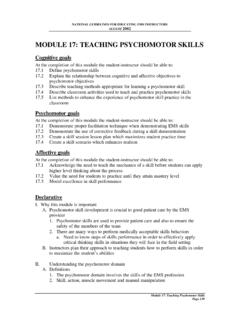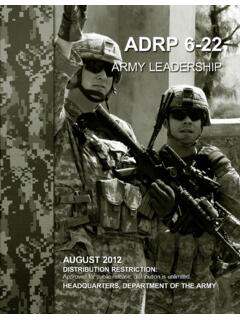Transcription of Great Teaching Evidence Review - cambridgeinternational.org
1 Evidence ReviewGreat Teaching ToolkitJune 2020In partnership withRob RauchStuart KimeDan BasedEducationEvidence Review | 2 Great Teaching ToolkitWithout collaboration, generosity and a shared will to help every teacher improve, there would be no Great Teaching Toolkit Evidence Review . The work so far has been a truly international project, with 74 collaborators from eleven countries around the world. To all these people listed below each of whom gave their time and wise feedback freely we say thank would also like to take this opportunity to express our thanks to Cambridge Assessment International Education, whose support has helped make this Review , particular credit is reserved for our partners at Ignio, with whom we work closely on many of our developments. The tireless input and invaluable expertise of Dan Singleton and his team is often unseen, but without it, you would not be reading this document you will discover, the Evidence Review is only the start of a project to transform teacher development.
2 We look forward to acknowledging the collaboration and wisdom of many more teachers, leaders, researchers, designers and policy-makers as we take our next steps together. Thank you to: Janice Allen* Falinge Park High School, RochdaleFatima Altawil Bunat Alghad Academy, JordanPhil Anderson Teach FirstPaul Beedle Cambridge Assessment International EducationAdam Boxer The Totteridge AcademyHazel Brinkworth Dulwich College Shanghai PudongGerard Calnin Education University of Hong KongRuth Carney Falinge Park High School, RochdaleRobbie Coleman Education Endowment FoundationSteve Dalgarno Dulwich College SuzhouShaun Daly Teach FirstRob Davies Swansea CouncilDavid Didau The Learning SpyMegan Dixon Aspire Educational TrustAnne Dwyer Yew Wah International Education FoundationMark Enser Heathfield Community CollegeKatie Fas Teach FirstSarah Flaherty Teach FirstHarry Fletcher-Wood Ambition InstituteVictoria Foster Dulwich College Shanghai PudongDeep Ghataura Heston Community SchoolSylwia
3 Glazewska Falinge Park High School, RochdaleDave Greenshields Grace College, GatesheadRory Gribbell Department for Education, EnglandRegan Gurung Oregan State UniversityJohn Hattie* University of MelbourneRoger Higgins Norwich Research SchoolClaire Hill Turner Free School, FolkestoneHeather Hill* Harvard UniversityMatt Hood Oak National AcademyToby Horrocks Ambition InstituteKevin House Dulwich College InternationalKat Howard The Duston School, NorthamptonAcknowledgementsEvidence Review | 3 Great Teaching ToolkitNicolas H bner Eberhard Karls University of T bingenBen Hughes Teach FirstAhmed Hussain Wellington College InternationalEdward James Ambition InstituteRory Johnson Falinge Park High School.
4 RochdaleMark Jones Dulwich College SuzhouNiki Kaiser Norwich Research SchoolIan Kelleher Center for Transformative Teaching and LearningVictoria Kelly Teach FirstMax Knogler Technical University of MunichCarolina Kuepper-Tetzel* University of GlasgowPeps Mccrea Ambition InstituteSteve Mills Whitehill Junior SchoolRachel Miller Teach FirstRebecca Mitchell Teach FirstSophie Morgan-Williams Ambition InstituteLindsay Morlock South Shields SchoolRoss Morrison McGill Teacher ToolkitDaniel Muijs OfstedRyan O Kane Falinge Park High School, RochdalePaula O Reilly Falinge Park High School, RochdaleRachel Ogden Falinge Park High School, RochdaleRachel Orr Teach FirstKaty Pautz Falinge Park High School, RochdaleLisa Pettifer Trinity School.
5 CarlisleMorgan Polikoff* University of Southern CaliforniaAlex Quigley Alex Quigley ConsultsJoAn Radojkovich Dulwich College InternationalNick Rose Ambition InstituteAmanda Seward Teach FirstTom Sherrington Teacherhead Karen Taylor International School of GenevaNatasha Tyrwhitt-Drake Teach FirstAdrie Visscher University of TwenteMick Walker** Chartered Institute of Educational AssessorsPaul Warwick University of CambridgeHelen Jennifer Webb Teach FirstDavid Weston Teacher Development TrustDylan Wiliam* The Dylan Wiliam CenterJames de Winter University of CambridgeEdward Wright* Eltham College* EBE Advisory Board**EBE Advisory Board ChairDesigned by 2020 Evidence Based EducationPublished by Evidence Based Education in partnership with Cambridge Assessment International Education Evidence Review | 4 Great Teaching ToolkitForewordTeaching should be a rewarding profession where teachers are empowered and supported to be the best creative professionals they can be.
6 The overwhelming body of research finds that the most important factor in improving student outcomes is good Teaching . Therefore, helping teachers become better is the most important responsibility we have as educational leaders, as it is the best way to help learners fulfil their , teacher autonomy, creativity and trust have been eroded in recent decades in some educational systems, by a drive toward compliance. While the goal has been noble to measure and rank institutional and individual performance, increase accountability and reduce variability the unintended consequence has often been to reduce teacher learning to formulaic practice. In these settings, feedback to teachers has not been as supportive and informative as it should be to give them control and ownership over their professional development and practice. In contrast, the Great Teaching Toolkit is a breath of fresh air treating teachers like the professionals they are.
7 It provides both a synthesis of Evidence from authoritative studies, and the findings of this Evidence , that teachers can relate to their own experience. What makes it so valuable is its clear focus on areas of practice that have the potential to improve student learning and outcomes. Professional learning happens when we think hard about our practice and take full ownership of it. Cambridge International is pleased to be able to sponsor this Review , which clearly defines what is worth teachers thinking hard about. These are principles and practices that we endorse and use in developing our own professional development services to schools, with the aim of helping teachers become confident, responsible, reflective, innovative and engagedAt the time of writing, the educational world is in turmoil caused by the Covid-19 crisis. Teachers have had to learn quickly to adapt, teach online and support learners in new ways.
8 A number of commentators have speculated on the implications for the future of schools and the nature of the Teaching profession. In such a climate, the Evidence -based insights provided in the Great Teaching Toolkit are even more significant. We believe that the Toolkit s universal and timely principles will be an invaluable resource to teachers and schools around the Tristian Stobie Director, Curriculum and Qualifications DevelopmentCambridge Assessment International EducationEvidence Review | 5 Great Teaching ToolkitExecutive SummaryWhat are the best bets for teachers to invest time and effort in if they want their students to learn more?We have reviewed existing research studies and frameworks that are relevant to the components and routes to improvement of teacher effectiveness. Our aim is to help teachers make better decisions about what they can best do to improve their effectiveness.
9 In summary, we have identified four priorities for teachers who want to help their student learn more: 1. understand the content they are Teaching and how it is learnt 2. create a supportive environment for learning3. manage the classroom to maximise the opportunity to learn4. present content, activities and interactions that activate their students thinkingWe present a model that comprises these four overarching dimensions, with a total of 17 elements within them. An element is defined as something that may be worth investing time and effort to work on to build a specific competency , skill or knowledge, or to enhance the learning environment. There is no implication that the complexity of Teaching can be reduced to a set of techniques, but Evidence suggests the best route to expertise is likely to involve a focus on developing competencies, guided by formative feedback in a supportive professional learning Review is the first stage of an ambitious wider project to create a Toolkit that will: personalise the curriculum for teacher learning (according to ages and subjects taught, school context and student characteristics, current profile of expertise, etc.)
10 Develop systems and instruments to provide formative, actionable feedback that helps teachers to focus their learning, evaluate their impact and track their professional growth coordinate networks for peer and expert support to generate, share and apply Evidence about the most effective ways to improveThe individual elements of the model for Great Teaching are as Review | 6 Great Teaching deep and fluent knowledge and flexible understanding of the content you are teachingPromoting interactions and relationships with all students that are based on mutual respect, care, empathy and warmth; avoiding negative emotions in interactions with students; being sensitive to the individual needs, emotions, culture and beliefs of studentsManaging time and resources efficiently in the classroom to maximise productivity and minimise wasted time ( , starts, transitions); giving clear instructions so students understand what they should be doing; using (and explicitly Teaching ) routines to make transitions smoothStructuring: giving students an appropriate sequence of learning tasks; signalling learning objectives, rationale, overview, key ideas and stages of progress; matching tasks to learners needs and readiness; scaffolding and supporting to make tasks accessible to all, but gradually removed so that all students succeed at the required levelInteracting: responding appropriately to feedback from students about their thinking/knowledge/understanding.
